News
The Shark Whisperers of Beqa Lagoon
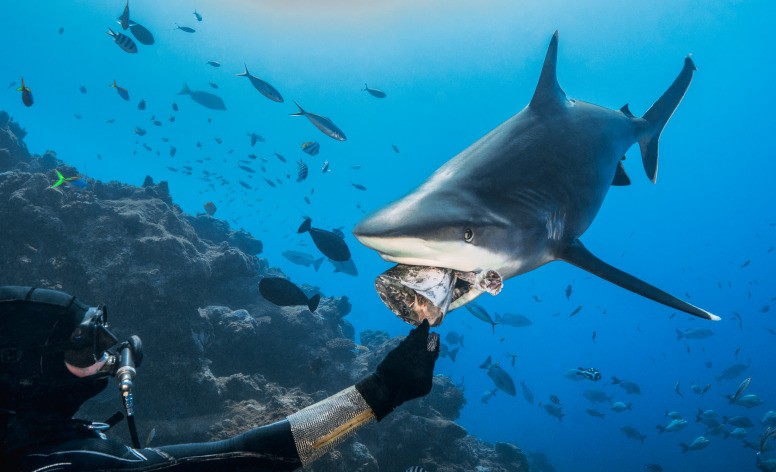
Legendary shark experts Ron and Valerie Taylor called it “the best shark dive in the world”. In Beqa Lagoon, brave men feed up to eight different shark species just a stone’s throw from your position. While the sight of the mingling whitetip, blacktip and grey reef sharks and the bigger nurse, silvertip and lemon sharks already provides for a spectacle in itself, it’s the world’s largest bull sharks who steal the show here. That is, until the biggest predator of these waters, the tiger shark arrives on scene. Yet the thrill these ultimate shark dives provoke is not the end goal of the organizing company. It’s part of a clever strategy that provides them the means to protect the sharks.
Shark Circus
As the sun rises over Fiji’s main island Viti Levu we are already on our way to Pacific Harbour, where the unique diving experience is being offered. Through the open windows of our rental car a cool breeze carries the scent of flowers and villagers greet us with a typical loud BULA! (hello, welcome), as we pass them. When we arrive at the dive center, the guides help us to unload our diving gear and within a half hour we are already on our way to Shark Reef. During the 25 minute passage on the Navua river and Beqa lagoon, we get a thorough briefing about the diving spot, the different shark species and the way every diver is expected to behave during the dive. The safety of both the divers and the sharks is a priority. Once on site, we jump into the water one by one and descend along a line down to The Arena, at a depth of 30 meters.

It is clear why they call this site The Arena as it really has a theater like setting. The central open space is lined by a semi-circular, 20 cm high coral rock wall. All participants are asked to sit down behind it. A large number of big bass, pacific jack mackerel and rainbow mackerel is already present, circling the bait containers. As soon as the shark feeders take their positions, the first sharks also appear. The nurse and lemon sharks are a bit of a motley crew. They rush into the arena from all sides, but soon realize they only get a fish head when they approach the feeders from the correct side. Meanwhile, two guides have placed themselves behind the spectators with long, flat-ended aluminum sticks. They gently push sharks that come in too close into the right direction.
Courageous little whitetip reef sharks boldly meander through the much larger shark species, looking for scraps. The silvertips’ behavior is entirely different. These alert and fast hunters prefer to patrol the edge of the arena until they have eye contact with one of the feeders. Then they cross the distance to their benefactor in the blink of an eye, and gobble up the offered food. After a few minutes the arena becomes increasingly crowded as ever more predators, including giant groupers and napoleon wrasse, are attracted by the food containers. Small and bigger coral fish circle ever faster in a frenzy, until they form a spiraling fish tornado. Behind it, we see the shadows of large predators appearing. The bull sharks have arrived! But they know that this is not their feeding spot, and that audacity will only be punished with a push and a tap of the aluminum push sticks. And so they patiently wait their turn.

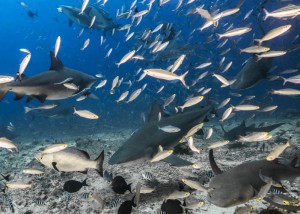
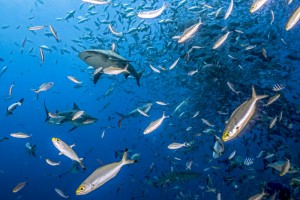

Safety stop with superior “entertainment”
After 17 minutes, the whole group moves to a platform at 10 meters, and everyone picks a spot behind the rope. This is where the grey reef sharks are being fed. Smart and graceful as they are, they prove to know the procedure well. The platform becomes like a runway when one by one, the grey reef sharks descend, all using the same flight path to the man holding the tube with bait.
For the last couple of minutes of the dive we move once more, this time to a flat reef at 4 meters, to feed the white tip and black tip reef sharks. Extremely shy as black tips generally are, this feeding session provides a unique opportunity to admire this beautiful species from up close.

During the surface interval, a new container of bait is lowered from a separate boat down to our second dive site and our guides elaborate on their job as shark feeders. They come from Beqa Island on the opposite site of Beqa Lagoon and they tell us that they are protected by a pact their ancestors made with the sharks. “We promised to never hurt sharks and in return they don’t bite us”. During the animated conversation we indulge ourselves, snacking on the offered cookies and coconut until we’re completely full. But meanwhile, deep down in the water and attracted by the irresistible scent of fish oil and tuna heads, increasing numbers of hungry apex predators anxiously await our return….
The grand finale
The setting of the second feeding session is once again an open central space lined by a wall, but this one is only 15 meters deep. Inside and near the wall we can see a perforated steel box on the bottom, containing the fish heads for the bull sharks. The shark feeder is flanked by two bodyguards this time, to stifle the possibility of an incident. The bull sharks are colossal and it is immediately obvious that this is no child’s play but a meticulously planned procedure built with expertise and experience. At first the sharks approach the feeders cautiously and calmly. But as the dive progresses, a few of the sharks get impatient and excited and things seem to get a bit hectic. While the group of feeding bull sharks passes, there are also still other sharks in the area and at certain moments the fish tornado moves right in front of our faces. But the guides have everything perfectly under control and any shark that falls out of line is immediately and decisively corrected using the push sticks. I don’t feel unsafe for a single moment.

After a quickly passing half hour, the show suddenly falls silent. The procession of bull sharks stops and the animals move to the background. I look up at the guides, reluctantly preparing myself to go back up, but then I see the reason for the abrupt change in atmosphere appearing. Long as a small submarine and with the unmistakable wide mouth and stripes on it’s back, the king of the Fijian waters has come to claim his share. A gorgeous tiger shark glides slowly and majestically into the open space. His confident, calm moves make it clear that he is very conscious of his power and size. He clearly knows that not a single animal in these waters poses a threat to him. The feeder holds up a large tuna head and we see him opening his enormous mouth while he slowly approaches the feeder. Its large teeth shine and a protective membrane covers its eyes before his massive jaws engulf the food. “What a incredible experience this is!”

The soul of the shark circus
The organization is sometimes criticized because the set up and interaction with the sharks is not natural and the sharks are conditioned by it. The owners of Beqa Adventure Divers (B.A.D.) confirm this themselves, but the show has a much bigger purpose than sensational entertainment by itself.
In 1999, when a dive guide made his first dive at a spot where, according to old sea charts, “Shark Reef” was situated, the only thing he found was a boring slope with debris, no sharks at all and barely some fish or coral growth. It was only after weeks of leaving bait behind, that he finally saw a couple of reef sharks. He then asked the elders of the villages responsible for the reef if he could bring divers along and feed the sharks. Every diver would pay a fee to the village if, in return, the villagers would stop fishing the reef. The elders agreed because they rarely caught any fish on the reef anyway.
Over the following years more and more sharks learned that the sound of a certain boat signaled a free meal. But the activity also attracted more and more other fish and the place gradually became a complete community, a vibrant local marine ecosystem. In 2004 the shark feeding sessions became so popular they were split between two organizations. By that time experts already counted 300 different fish species on Shark Reef, which by then had not been fished upon since five years. Consequently, the fish catches in the neighboring villages were also increasing while the reef owners’ income was secured by the divers’ fees.
Win-win for everyone and especially for the sharks
Now, the proceeds of the shark dives are being used for several noble purposes and the organization has secured national protection of the reef. The Fijian government was convinced of the economic value of the thriving business, because every shark diver contributes to the economical welfare of the country through his overnight stays, his restaurant visits and transport. Moreover, the shark diving operations create jobs. This resulted in a 50 km long passage between Viti Levu and Beqa Island to be declared Fiji’s first shark sanctuary. The whole area is now an official no-take zone under the control of B.A.D. To ensure enforcement, the company trained 12 local rangers. The Swiss non-profit organization The Shark Foundation donated a patrol boat for this purpose. A portion of the proceeds is also being used to plant mangroves on various islands in the country. These function as nurseries for fish species and protect the Fijian coastlines against storm surges. Thanks to the mangrove program, BAD is now also a carbon neutral dive operation and the program has been made available for anyone to copy, to encourage other dive operations to offset their carbon footprint too.

Finally, the diving fees are also used to finance scientific research. The bull sharks’ migration route was investigated by tagging the sharks. The results showed that the sharks frequent all corners of the Fijian waters and even far beyond. With this evidence in hand, B.A.D. is now working with the government to ban shark fishing throughout the country. It is certainly necessary as longlining by foreign fisheries is allowed in Fiji’s national waters and village elders can autonomously decide whether their fishermen are allowed to target sharks (and sell the fins) or not. This despite the fact that the company has amply proved that live sharks represent a much higher value compared to the sale of shark fins.
Safety first
The shark dive companies are very aware that their success or failure depends on the level of safety they can guarantee their customers. Therefore they apply very strict safety rules. It is mandatory for all guests to wear a black diving suit covering the entire body, and black gloves. There are suits available at the dive center. The guides also demand undivided attention from each diver during the briefings. Cameras can only be used with arms bent tightly against the body and the use of an extension handle on a Go-Pro is not allowed. The team of guides generally consists of five people: the shark feeder, two bodyguards to protect the shark feeder and two guides who stand guard for the guests. Moreover, each guest who has less than 30 dives on his record gets a personal guide, while the maximum number of participants on each trip is limited to 20.
Also essential to avoid incidents is of course the training of the shark feeders. Generally new employees are first introduced to other functions within the company, like steering the boat or managing the diving center. Once convinced of the character and skills of a potential feeder, they start a six-month intensive training to learn the strict procedures to follow while feeding. For example, sharks are always fed using the same hand while the other arm is folded tightly against the body and food can only be offered when the shark approaches from the correct direction. If the shark approaches from the wrong direction, then the food is hidden.

In addition, the intern-feeders are introduced into the science of shark behavior. Accompanied by established marine biologists and experienced feeders, the intern-feeder watches numerous videos of past feeding sessions, during which the sharks’ behavior is analyzed. Due to the extensive training and experience of the shark whisperers, there has never been a single bite incident in their many years of operation. The number of shark attacks in Fiji’s waters hasn’t gone up since the startup of the company either. The official explanation for the low number of incidents with sharks in Fiji, despite the large number of sharks living in their waters, is that the rich fish stocks keep the sharks well fed. “But maybe”, we wonder, “it might also have something to do with that mysterious pact the shark whisperers made with the sharks”.

Frame
The Fiji archipelago consists of 333 islands of which only one-third is inhabited. The islands lie extremely isolated in the South Pacific, 4450 km Southwest of Honolulu, Hawaii and 3430 km East of Queensland, Australia. The expansive region (including national waters) covers an area of more than 18,300 km2.
Travel information
Climate
Fiji enjoys a tropical climate. It can be dived all year round. The air temperature is between 25-32°C all year round. The dry season runs from June to October. These months offer the best visibility, but occasionally brisk winds can be blowing. The water temperature drops during this period to a minimum of 22-23°C. The rainy season can be felt between December and April. It is characterized by calm days and warmer water between 26-30°C. The visibility drops slightly in this period but is still up to 20 meters. December to March is hurricane season. Some islands receive considerably more rain than others. The mountains on Viti Levu divide the island between a dry northwestern part and a much more moist southeastern part.
Flights
Korean Air operates flights from Amsterdam to Seoul, South Korea, taking 9 hours 45 minutes and then onwards after a stopover of five hours, from Seoul to Nadi, Fiji in 10,5 hours.
Other companies that offer a smooth transfer are Cathay Pacific and Qantas.
Ultimate sharkdive
Two companies offer the ultimate shark dive at Shark Reef departing from Pacific Harbour.
Beqa Adventure Divers: The two dives take place at different sites. During the first dive, different shark species are being fed on separate levels: 30, 10 and 4 meters. For the second dive they move to a dive site at 15 meters, after which they do a safety stop on the reef. (Semi) professional photographers who join multiple trips are sometimes allowed a spot in the arena next to the feeder. Their ultimate shark dive is offered on Mondays, Tuesdays, Thursdays and Saturdays. www.fijisharkdive.com

Aqua-Trek: Both dives are conducted at the same dive site at 18 meters depth. There’s a wreck situated next to the arena, which is used to do the safety stops. In agreement with the guides, photographers are sometimes allowed to sit at a separate spot with better views. Their ultimate shark dive is offered on Mondays, Wednesdays, Fridays and Saturdays. www.aquatrek.com
Stay
Pacific Harbour is a small coastal tourist town with a few moderate to expensive hotels.
We preferred to stay at Maui Palms (www.mauipalms-accommodation.com) at the beach of Korolevu, 35 km from Pacific Harbour. The romantic mini resort consists of 4 well cared for bungalows, which are situated just meters from the sandy beach and beautiful coral reef. At high tide baby blacktip reef sharks swim up to the waterfront and you can snorkel with them. The location is also perfect to visit the other highlights of the area.
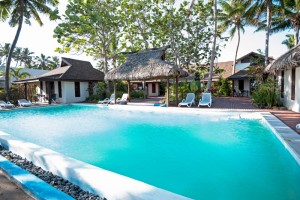

Car rental
Multiple international car rental agencies are present in Fiji, but we preferred to work with the local company Khans Rental Cars (www.khansrental.com.fj). They offer the best prices in Viti Levu. Driving the company owner to the bus stop after receipt of our rental car was all part of the adventure.
[hr style=”single”]
Story: Katrien Vandevelde
Pictures: Katrien Vandevelde & Jan Wouters; © BlueShark Conservation; www.blueshark.be
News
Book Review: Fire on Monroe Bravo by Fred Lockwood
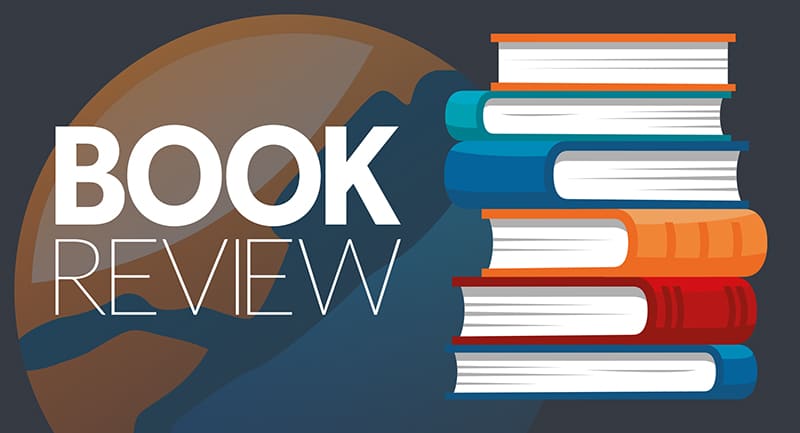
Fire on Monroe Bravo is the latest book in the Jack Collier series by Fred Lockwood. Our story begins with our lead characters, Jack and Sandro, owners of Marine Salvage & Investigation Company, arriving on the Monroe Bravo Oil & Gas Platform in the North Sea. Having secured a contract for their vessel the MV Stavanger to act as support ship to the platform for TransGlobal Oil, our protagonists are on a celebratory visit.
However almost as soon as they arrive a series of explosions rock the platform, causing huge damage, loss of life and the very real danger of a massive human, ecological and financial disaster.

As the danger mounts for both our heroes and the surviving workers, Jack and Sandro will have to escape the inferno, all while trying to save the platform and the men still trapped unable to help themselves.
The disaster sets the scene for the unfolding story lines following the fate of the platform and our main characters, the police investigation into a suspected terrorist act and the actions of TransGlobal Oil as they attempt to navigate the pubic outcry and financial repercussions.
In his eighth book, Fire on Monroe Bravo, Fred Lockwood delivers an explosive thriller, with plenty of above and in-water drama, and our heroes fighting for survival, what more can you ask for?
We thoroughly recommend this read and look forward to the next in the series. For more information about his book series, you can check out the reviews of his previous books here on Scubaverse.
- Title: Fire On Monroe Bravo
- Author: Fred Lockwood
- ISBN: 979-8325324536
Available in a paperback version and for Kindle from Amazon and book stores.
Blogs
Alonissos: The complete diving destination (Part 1)

In June we were incredibly fortunate to be invited to dive in Alonissos, a small Greek Island in the Sporades island chain located in the North Aegean Sea. While I have long been a big fan of the Greek Islands as a great holiday destination, I had not had the opportunity to do any diving on previous visits and Mike and I were extremely excited to see what Alonissos had to offer both above and below the surface!

The Sporades are easily accessible via the airport in Skiathos (the first island in the chain), which is served by Jet2 flights from all major UK airports from May through October. Numerous ferries and charter boats make island hopping from Skiathos Town a breeze. After an hour boat ride, the picturesque port of Patitiri was a wonderful introduction to Alonissos, where we were met by our gracious hosts Kostas of Albedo Travel and Dias of Alonissos Triton Dive Center. Mike and I were delighted to be staying at the Paradise Hotel, aptly named for its stunning views over the sea and great location for walking to the waterfront.

Alonissos is beautifully situated in the National Marine Park of Alonissos and the Northern Sporades, the largest marine protected area in Europe. The surrounding seas offer fabulous marine life, including incredibly rare species such as the Mediterranean monk seal. They boast deep walls covered in gorgonians and sponges, stunning topography with caverns, swimthroughs and pinnacles, and the first accessible ancient shipwreck from 500BC!

In locations where historical sites have been reported, the waters are largely restricted, but with collaboration between government, underwater archeologists and dive centres, incredible underwater museums are being created for a truly unique diving experience. Alonissos is home to the first of these, the Ancient Shipwreck of Peristera Accessible Underwater Archeological Site. The chance to dive into history (along with reports of healthy reef life and amazing underwater topography) meant Mike and I were keen to get in the water.

Our introduction to the diving around Alonissos was at the Agios Georgios Pinnacles, in the channel between Alonissos and Skopelos. This fantastic site was named “The Chimney,’ and proved to have a huge amount to see. We got to a decent depth here (over 25m), and marvelled at a colourful reef wall with a wonderful swim through whose rocky walls were absolutely covered with life. As well as brilliant topography there was no shortage of macro life here. We saw numerous nudibranchs, five different species in total. The second dive at Mourtias reef nearby was a shallower dive along a nice wall with lots of crevices. Several moray eels and grouper called this site home. We enjoyed looking in the crevices for lobster and smaller benthic life, such as cup corals and tunicates.

Our itinerary allowed us two dives a day with afternoons left to explore the island with our hire car and evenings to enjoy the famous Greek hospitality. This proved to be a lovely mix of in-water and land based diversions.

The next days diving to the Gorgonian Gardens and Triton’s Cave was to be even better! These two stunning sites are nothing short of fabulous. The Gorgonian Gardens was a deep wall near to the Agios Georgios islands. The ever-present currents in this deep channel meant that the sea life was amazing … the namesake Gorgonian sea fans dotted the wall at a depth of 30 to 50 meters, getting ever larger the deeper we went. Above 30m was by no means less beautiful, with sponges, corals, scorpionfish, moray eels and some rare and colourful nudibranchs.

The second shallower dive of the day was to Triton’s Cave or the Cavern of Skopelos, on the east side of that island. The spectacular rock formations had wild striations both above and below the water making a truly epic topography. The cavern entrance was at 14m, and big enough for a buddy pair, winding up to 6m and passing two beautiful windows out into the blue. Emerging from the cavern, the light at the shallower depths and the incredible rock formations made for a fantastic gentle swimming safety stop and we all surfaced by the boat with massive grins.

Check out our next blog :Alonissos: The complete diving destination (Part 2)” to hear about our amazing dive on the 2500 year old Peristera Wreck!
Thanks to:
Alonissos Triton Dive Center https://bestdivingingreece.com/
Albedo Travel https://alonissosholidays.com/activities/
Paradise Hotel https://paradise-hotel.gr/
Alonissos Municipality https://alonissos.gr/en/
-

 Blogs2 months ago
Blogs2 months agoDiving With… Nico, Ocean Earth Travels, Indonesia
-

 News1 month ago
News1 month agoMurex Bangka Announce New Oceanfront Cottages & Beachfront Dining
-

 Blogs2 months ago
Blogs2 months agoA new idea in freediving from RAID
-

 Marine Life & Conservation1 month ago
Marine Life & Conservation1 month agoIceland issue millionaire whale hunter a licence to murder 128 vulnerable fin whales
-

 Marine Life & Conservation2 months ago
Marine Life & Conservation2 months agoThe Shark Trust Great Shark Snapshot is back
-

 News3 months ago
News3 months agoCharting New Waters; NovoScuba Goes Global with the Launch of their Revolutionary Dive Training Agency!
-

 Gear News1 month ago
Gear News1 month agoNew Suunto Ocean – a dive computer and GPS sports watch in one for adventures below and above the surface
-

 Marine Life & Conservation Blogs2 months ago
Marine Life & Conservation Blogs2 months agoBook Review: Plankton















